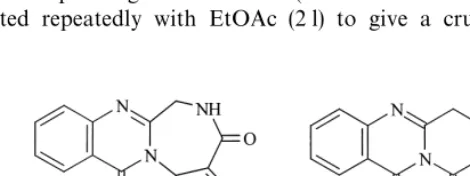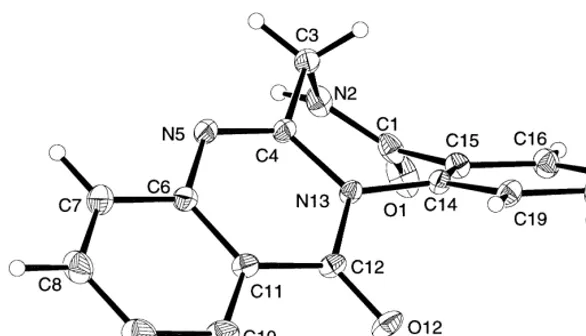*Corresponding author. Tel.:#45-45-25-26-32; fax:#45-45-88-49-22. E-mail address:[email protected] (T. Ostenfeld Larsen)
UV-guided screening of benzodiazepine
producing species in
Penicillium
Thomas Ostenfeld Larsen
!
,
*
, Karla Frydenvang
"
,
Jens Christian Frisvad
!
!Mycology Group, Department of Biotechnology, Building 221, Technical University of Denmark, DK-2800 Lyngby, Denmark
"Department of Medicinal Chemistry, Royal Danish School of Pharmacy, Universitetsparken 2, DK-2100 Copenhagen, Denmark
Received 22 July 1999; accepted 21 October 1999
Abstract
The benzodiazepine sclerotigenin (auranthine B) recently described as a metabolite of
Penicillium sclerotigenum, has been isolated as the major metabolite from an isolate of P. commune. The structure of sclerotigenin was established by a single-crystal X-ray di!raction study and by NMR spectroscopy. UV-guided screening for benzodiazepine production by other penicillia revealed that sclerotigenin was also produced by isolates ofP.clavigerum,P.
lanosum, P.melanoconidium,P.sclerotigenum andP.verrucosum. Sclerotigenin was detected both intra- and extracellularly. Apparently,P.aurantiogriseumis the only auranthine producing species in genusPenicillium. ( 2000 Elsevier Science Ltd. All rights reserved.
Keywords: Penicillium; Benzodiazepines; Sclerotigenin; Auranthine; Chemotaxonomy
1. Introduction
For more than 20 years we have studied the taxonomy and classi"cation of species in genusPenicilliumfrom a combined morphological and chemical approach (Frisvad and Filtenborg, 1983, 1989; Larsen and Frisvad, 1995). In these studies secondary
Table 1
Penicillium isolates screened for benzodiazepine production
P. aurantiogriseum: IBT 3992, 5134, 5268, 11301, 11325, 12834, 12836, 13169. P. commune: IBT 3427, 6200, 10727, 10837, 10924, 12807, 16710, 18102. P. clavigerum: IBT 4899, 5523, 6336, 14991, 14993, 19355, 19361, 21512. P. lanosum: IBT 13448, 15554, 18774, 19190, 19714, 19718, 19933, 19992. P. melanoconidium: IBT 3928, 4107, 6672, 6794, 11406, 14367, 15448, 15983. P. sclerotigenum: IBT 12466, 13826, 13938, 14346, 15061.
P.verrucosum: IBT 5252, 6734, 14248, 14249, 14257, 14875, 15212, 21025. Fig. 1. Structure of sclerotigenin and auranthine.
metabolites are extracted in micro-scale (Filtenborg and Frisvad, 1980; Smedsgaard, 1997) and analysed and identi"ed primarily by HPLC coupled to UV}VIS detection or ES-MS (Frisvad, 1987; Svendsen and Frisvad, 1994; Smedsgaard and Frisvad, 1997).
More recently, we have initiated UV-guided isolation of metabolites of physiolo-gical or chemotaxonomical signi"cance with some focus on amino acid derived metabolites, like diketopiperazines and quinazolines (S+rensen et al., 1999; Larsen et al., 1998b, 1999). Due to the very similar UV characteristics of quinazolines and benzodiazepines our attention was drawn to a possible novel benzodiazepine metab-olite (`auranthine Ba), produced by an isolate ofP. commune. The UV-spectrum of auranthine B was almost identical to the UV spectrum of auranthine from P. aurantiogriseum(Fig. 1, Yeulet et al., 1986).
2. Materials and methods
A total of 53Penicilliumisolates (Table 1), all obtained from the Culture Collection at the Department of Biotechnology (IBT), Technical University of Denmark were used in the present study.
Fig. 2. Perspective drawing (Johnson, 1976) of sclerotigenin. Displacement ellipsoids enclose 50% prob-ability. Hydrogen atoms are represented by spheres of arbitrary size. Bond lengths and angles are in agreement with expected values (Allen et al., 1995). The conformation of the molecule is dominated by the planar parts of the compound, i.e. the aromatic moieties and the amide moieties. The seven-membered ring adopts a C
Sboat conformation (Spek, 1990). In the crystal packing a hydrogen bond is observed from the amide hydrogen atom (N2}H) to the amide carbonyl oxygen atom (O12) of a symmetry related molecule. The packing shows layers of hydrogen bonded molecules and the layers are held together by van der Waals interactions.
evaporation of the solvent. 620 mg of pure sclerotigenin was obtained from chromatography on a Merck Lichroprep Si (25 mm]310 mm, 40}63lm) column using CH
2Cl2}MeOH (97 : 3) as mobile phase at 16 ml/min#ow rate. Only part of
the 620 mg of the pure sclerotigenin could be dissolved in 100 ml boiling MeOH. The MeOH phase was left in the refrigerator overnight to give more than 100 mg of colourless prisms.
A single crystal was used to collect X-ray di!raction data on an Enraf-Nonius CAD-4 di!ractometer using graphite monochromated Mo K
a radiation. Data were processed using the programs of Blessing (DREADD) (Blessing, 1987, 1989, 1997) (details in deposited material).
The structure of sclerotigenin (Fig. 2) was solved by direct methods using the programme SHELXS97 (Sheldrick, 1990, 1997a) and re"ned using the programme SHELXL97 (Sheldrick, 1997b). Full matrix least-squares re"nement on F2 was performed, minimizing+w(F2
0!F2#)2, with anisotropic displacement parameters for
the non-hydrogen atoms. The positions of the hydrogen atoms were located from intermediate di!erence electron density maps and re"ned with "xed isotropic displacement parameters. The re"nement (223 parameters, 5423 re#ections) converged at R
F"0.042, wRF2"0.111 for 4331 re#ections with F0'4p(F0); w"1/[p(F2
0)#(0.0689P)2#0.24P], whereP"(F20#2F2#)/3);S"1.020. In the"nal
di!erence Fourier map maximum and minimum electron densities were 0.49 and
The13C NMR data, recorded at 100.6 MHz (DMSO-d6: 167.1, 161.0, 154.9, 146.2, 135.2, 133.5, 130.8, 130.7, 129.8, 128.8, 128.6, 127.6, 127.1, 127.0, 121.1 and 46.3 ppm), were in keeping with the data reported by Joshi et al. (1999).
The 53 isolates of P. aurantiogriseum, P. commune, P. clavigerum, P. lanosum, P. melanoconidium, P. sclerotigenum and P. verrucosum were cultivated on CYA and YES, and screened for production of benzodiazepines, both inside and outside of colonies, using the agar plug extraction procedure and HPLC analysis as described by Smedsgaard (1997). Retention indices (RI) of fungal metabolites were calculated according to Frisvad and Thrane (1987).
3. Results and discussion
HPLC analysis con"rmed that auranthine (RI"835) is consistently produced by
P. aurantiogriseum as reported by Lund and Frisvad (1994). According to our knowledge no other penicillia is capable of producing auranthine.
Sclerotigenin (RI"705) was found to be produced by isolates in six di!erent
Penicillium species. All investigated isolates of each of the three species P. scler-otigenum,P. lanosumandP. melanoconidiumproduced sclerotigenin (see Table 1).
However, sclerotigenin was inconsistently produced by P. verrucosum, P. clavigerumandP. commune. Only four of the eight investigatedP.verrucosumisolates (IBT: 6734, 14248, 14257, 21025), two of theP.clavigerumisolates (IBT: 4899, 19355) and just one of theP. communeisolates (IBT 3427) were found as producers.
Besides sclerotigenin, IBT 3427 among others produced cyclopiazonic acid, cyclo-paldic acid, palitantin and a series of non-characterized metabolites belonging to the same biosynthetic family (`metabolite-I analoguesa), all typical metabolites for P. commune (Lund, 1995). Likewise, the four sclerotigenin producing P. verrucosum isolates had a typical pro"le of secondary metabolites for the species, including verrucolone (Larsen et al., 1998a), ochratoxin A (Frisvad and Filtenborg, 1989), together with quinazoline (Larsen et al., 1999) and metabolite-I analogues. In addition to that IBT 15212 produced citrinin. The two sclerotigenin producingP. clavigerum isolates also produced patulin, asperfuran, penitrem A, lichexanthone and TAN-1612. These latter metabolites are typical forP. clavigerumand were also produced by the six otherP. clavigerumisolates investigated here.
The production of large quantities of a secondary metabolite in a few isolates of a species may, on the other hand, be an indication of a new speciation and so is of great interest. For example the isolate ofP. commune producing sclerotigenin was isolated from acorns in Spain where insect interaction is possible, whereas most other P. commueisolates are associated to cheese (Lund et al., 1995) where mite interaction rather than insect interaction is possible.
Sclerotigenin was"rst isolated from sclerotia ofP. sclerotigenumand was found to have antiinsectan activity, which was why Joshi et al. (1999) suggested sclerotigenin to play a role in the longevity of sclerotia. In this study one isolate of each of the six Penicilliumspecies was investigated for appearance of sclerotigenin both intra- and extracellularly. All isolates were found to contain large amounts of sclerotigenin in their spores (or mycelium). None of the investigated P. sclerotigenum isolates (or isolates of the"ve other studied species), produced sclerotia. Sclerotigenin was also found in relatively large extracellular concentrations inP. commune,P. sclerotigenum and P. lanosum and in minor extracellular amounts in P. clavigerum, P. melanoconidumandP. verrucosum. This was surprising since pure sclerotigenin was di$cult to dissolve in many organic solvents and in particular in water.
Since the biological activity of sclerotigenin has already been demonstrated our results indicate that sclerotigenin may also play a role in the chemical defense of both growing mycelium and spores.
4. Deposited material
Tables for the compound sclerotigenin list details for data collection, processing and re"nement, "nal atomic coordinates, equivalent isotropic displacement para-meters, anisotropic displacement parameters for non-hydrogen atoms, and a full list of bond lengths, bond angles, torsion angles and hydrogen bond dimensions and list of structure factors. The crystallographic CIF"le has been deposited at the Cambridge Crystallographic Data Centre, 12 Union Road, Cambridge CB2 1EZ, UK (Depos-ition no. CCDC 134800).
Acknowledgements
The technical assistance of Mr. F. Hansen with the X-ray data collection is gratefully acknowledged. The support of the Lundbeck Foundation, the Danish Dairy Foundation (Danish Dairy Board) and the Danish Research and Development Programme for Food Technology is acknowledged.
References
Blessing, R.H., 1987. Data reduction and error analysis for accurate single-crystal di!raction intensities. Crystallogr. Rev. 1, 3}58.
Blessing, R.H., 1989. DREADD*data reduction and error analysis for single crystal di!ractometer data. J. Appl. Crystallogr. 22, 396}397.
Blessing, R.H., 1997. Outlier treatment in data merging. J. Appl. Crystallogr. 30, 421}426.
Filtenborg, O., Frisvad, J.C., 1980. A simple screening method for toxigenic moulds in pure cultures. Lebensm. Wiss. Technol. 13, 128}130.
Frisvad, J.C., 1987. High-performance liquid chromatographic determination of pro"les of mycotoxins and other secondary metabolites. J. Chromatogr. 392, 333}347.
Frisvad, J.C., Filtenborg, O., 1983. Classi"cation of terverticillate penicllia based on pro"les of mycotoxins and other secondary metabolites. Appl. Environ. Microbiol. 46, 1301}1310.
Frisvad, J.C., Filtenborg, O., 1989. Terverticillate penicillia: Chemotaxonomy and mycotoxin production. Mycologia 81, 837}861.
Frisvad, J.C., Thrane, U., 1987. Standardized high-performance liquid chromatography of 182 mycotoxins and other fungal metabolites based on alkylphenone retention indices and UV-VIS spectra (diode array detection). J. Chromatogr. 404, 195}214.
Frisvad, J.C., Thrane, U., Filtenborg, O., 1998. Role and use of secondary metabolites in fungal taxonomy. In: Frisvad, J.C., Bridge, P.D., Arora, D.K. (Eds.), Chemical Fungal Taxonomy. Marcel Dekker, New York, pp. 289}319.
Johnson C.K., 1976. ORTEP II. A Fortran thermal}ellipsoid plot programme for crystal structure illustrations. Report ORNL-5138. Oak Ridge National Laboratory, Oak Ridge, TN.
Joshi, B.K., Gloer, J.B., Wicklow, D.T., Dowd, P.F., 1999. Sclerotigenin: A new antiinsectan benzodiazepine from the sclerotia ofPenicillium sclerotigenum. J. Nat. Prod. 62, 650}652.
Larsen, T.O., Frisvad, J.C., 1995. Chemosystematics ofPenicilliumbased on pro"les of volatile metabolites. Mycol. Res. 99, 1167}1174.
Larsen, T.O., Frydenvang, K., Frisvad, J., Christophersen, C., 1998a. Arabenoic acid (verrucolone), a major chemical indicator ofPenicilliumverrucosum. Biochem. System. Ecol. 26, 463}465.
Larsen, T.O., Frydenvang, K., Frisvad, J., Christophersen, C., 1998b. UV-guided isolation of alantrypinone, a novelPenicilliumalkaloid. J. Nat. Prod. 61, 1154}1157.
Larsen, T.O., Franzyk, H., Jensen, S.R., 1999. UV-guided isolation of verrucines A and B, novel quinazo-lines fromPenicilliumverrucosumstructurally related to anacine fromPenicillium aurantiogriseum. J. Nat. Prod. 62, 1578}1580.
Lund, F., 1995. Diagnostic charaterization ofPenicillium palitans,P. communeandP. solitum. Lett. Appl. Microbiol. 21, 60}64.
Lund, F., Filtenborg, O., Frisvad, J.C., 1995. Associated myco#ora of cheese. Food Microbiol. 12, 173}180. Lund, F., Frisvad, J.C., 1994. Chemotaxonomy ofPenicillium aurantiogriseumand related species. Mycol.
Res. 98, 481}492.
Sheldrick, G.M., 1990. Phase annealing in SHELX-90: Direct methods for larger structures. Acta Crystal-logr. A46, 467}473.
Sheldrick, G.M., 1997a. SHELXS97. Program for the solution of crystal structures; University of GoK ttin-gen. GoKttingen, Germany.
Sheldrick, G.M., 1997b. SHELXL97. Program for crystal structure re"nement. University of GoKttingen, GoKttingen, Germany.
Smedsgaard, J., 1997. Micro-scale extraction procedure for standardized screening of fungal metabolite production in cultures. J. Chromatogr. 760, 264}270.
Spek, A.L., 1990. PLATON, an integrated tool for the analysis of the results of a single crystal structure determination. Acta Crystallogr. A46, C34.
Svendsen, A., Frisvad, J., 1994. A chemotaxonomic study of the terverticillate penicillia based on high performance liquid chromatography of secondary metabolites. Mycol. Res. 98, 1317}1328.
S+rensen, D., Larsen, T.O., Christophersen, C., Nielsen, P.H., Anthoni, U., 1999. Dipodazine, a diketopiperazine fromPenicillium dipodomyis. Phytochemistry 51, 1181}1183.

